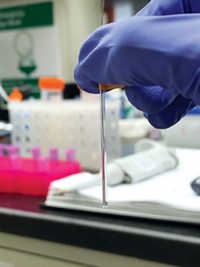Advertisement
Grab your lab coat. Let's get started
Welcome!
Welcome!
Create an account below to get 6 C&EN articles per month, receive newsletters and more - all free.
It seems this is your first time logging in online. Please enter the following information to continue.
As an ACS member you automatically get access to this site. All we need is few more details to create your reading experience.
Not you? Sign in with a different account.
Not you? Sign in with a different account.
ERROR 1
ERROR 1
ERROR 2
ERROR 2
ERROR 2
ERROR 2
ERROR 2
Password and Confirm password must match.
If you have an ACS member number, please enter it here so we can link this account to your membership. (optional)
ERROR 2
ACS values your privacy. By submitting your information, you are gaining access to C&EN and subscribing to our weekly newsletter. We use the information you provide to make your reading experience better, and we will never sell your data to third party members.
Persistent Pollutants
Photocatalyst shreds drinking water contaminant PFOA
A new bismuth-based catalyst is the fastest photocatalyst yet to degrade the perfluorinated pollutant
by Deirdre Lockwood, Special to C&EN
September 6, 2018
| A version of this story appeared in
Volume 96, Issue 36

A new photocatalyst could help clean up the industrial pollutant perfluorooctanoic acid (PFOA), which contaminates drinking water in many parts of the U.S. and recently triggered a state of emergency in Michigan (Environ. Sci. Technol. Lett. 2018, DOI: 10.1021/acs.estlett.8b00395). PFOA and another common perfluorinated contaminant, perfluorooctane sulfonate (PFOS), may threaten human health through chronic exposure at the parts per trillion level by increasing the risk of cancer and effects on reproduction, development, the liver, immune system, and more. The compounds, valued for their surfactant and water repellent properties, were once used to make products like Teflon, Scotchgard, and firefighting foams.
Unfortunately, it is not easy to remove these chemicals from water. With their strong carbon-fluorine bonds, they’re “among the most recalcitrant pollutants ever produced,” says Timothy Strathmann, an environmental engineer at Colorado School of Mines, who was not involved in developing the new catalyst. Granular activated carbon is most often used to pull perfluorinated molecules out of water, but it’s fairly inefficient because naturally present organic matter also sticks irreversibly to the carbon, using up its capacity to grab the pollutants. So scientists have been testing alternatives to sorption, such as advanced oxidation and reduction methods that break down perfluorinated chemicals into less harmful products. For example, Ezra L. Cates of Clemson University is developing semiconductor particles that are excited by UV radiation and act as photocatalysts to degrade the compounds. But it has been a challenge to find catalysts with the right properties to break the tough carbon-fluorine bonds.

Cates and his colleagues made an accidental breakthrough while testing the photocatalyst bismuth phosphate. After finding that it could break down PFOA as effectively as a previously reported photocatalyst, gallium oxide, they tried to improve its performance by varying the pH of the reaction used to make the catalyst particles. The researchers had hoped this would change the particles’ size and shape, but the process inadvertently produced bismuth oxyhydroxyphosphate (BOHP). This new catalyst has the highest photocatalytic activity for PFOA degradation ever reported.
In lab tests under UV light, BOHP degraded all the PFOA in a 130 μM solution in about an hour, roughly 15 times faster than did bismuth phosphate or gallium oxide. BOHP performed almost as well over five repetitions of the experiment, suggesting it can be reused. To simulate PFOA-contaminated groundwater, the researchers then tested a more dilute solution of 1.2 μM PFOA accompanied by 500 μg dissolved organic carbon/L. In this case, the photocatalyst also degraded all the PFOA, though it took two hours. Strathmann calls it a “promising development” that advances the application of photocatalytic treatment of PFOA.
Cates suggests that BOHP degrades PFOA so quickly because its beefed up hydroxide content gives it a highly positively charged surface at the low pH of the experiments compared with bismuth phosphate, attracting the negatively charged PFOA.
Advertisement
By monitoring some of the products of the reaction, the team found that 63-84% of the PFOA was converted into benign products such as fluoride ions and carbon dioxide. Cates says they will soon be analyzing the remaining products to determine whether shorter-chain perfluorinated compounds remain.
The team also found that BOHP does not degrade the more recalcitrant PFOS, so a complete purification system would require sequential treatment with different photocatalysts or other technologies, Cates says. He and his team are now working with the company Purifics to carry out pilot-scale tests of the catalyst on groundwater samples from military sites contaminated by firefighting foam.




Join the conversation
Contact the reporter
Submit a Letter to the Editor for publication
Engage with us on Twitter